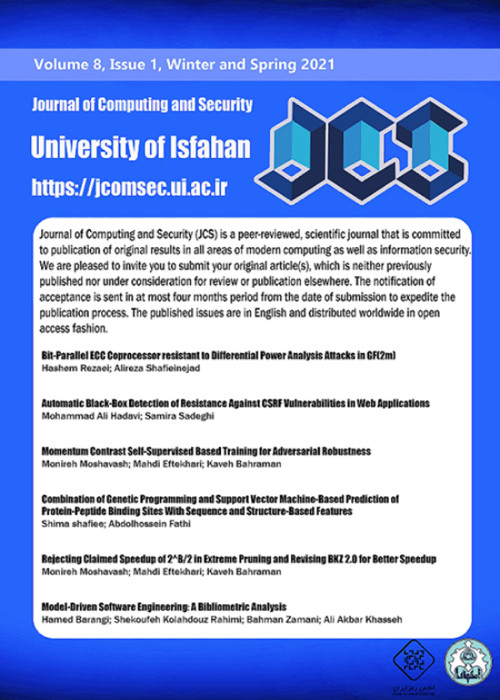فهرست مطالب
Journal of Computing and Security
Volume:5 Issue: 2, Summer and Autumn 2018
- تاریخ انتشار: 1397/04/10
- تعداد عناوین: 3
-
-
Pages 59-65
Certificateless cryptography can be considered as an intermediate solution to overcome the issues in traditional public key infrastructure (PKI) and identity-based public key cryptography (ID-PKC). There exist a vast number of certificateless signature (CLS) schemes in the literature; however, most of them are not efficient enough to be utilized in limited resources environments such as Internet of things (IoT) or Healthcare Wireless Sensor Networks (HWSN). Recently, two lightweight CLS schemes have been proposed by Karati et al. and Kumar et al. to be employed in IoT and HWSNs, respectively. While both schemes are claimed to be existentially unforgeable, in this paper, we show that both these signatures can easily be forged. More specifically, it is shown that 1) in Karati et al.'s scheme, a type 1 adversary, considered in certificateless cryptography, can generate a valid partial private key corresponding to any user of its choice and as a consequence, it can forge any users' signature on any message of its choice, and 2) in Kumar et al.'s scheme, both types of adversaries which are considered in certificateless cryptography are able to forge any signer's signature on an arbitrary message.
Keywords: Certificateless cryptography, Cryptanalysis, Signature, Industrial Internet of Things, Healthcare Wireless Sensor Networks -
Pages 67-79
Service-based application (SBA) is composed of software services, and those services may be owned by the developing organization or third parties. To provide functionalities based on the user’s preferences, SBA’s constitute services should be selected dynamically at runtime. For each distinct user’s request, we aim at finding a sequence of services which mostly satisfies user's preferences. Furthermore, we aim at reporting in a systematic manner the list of relevant contributions similar to our work focusing on the adaptation mechanisms. We applied Hidden Markov Model (HMM) to propose a QoS-based service selection method. The method is presented in three steps: Modelling, Learning, and QoS-based Selection. We used real-world QoS dataset to investigate the fitness and the execution time of the method. We compared this work with GSA-based and PSO-based service selection methods. We built and trained an HMM for selecting services for a given sequence of tasks in which the selected services are mostly aligned with user's preferences. Experimental results showed that our method achieves the maximum fitness in a reasonable time. Since service-oriented environments are ever changing, unsupervised learning approaches like Maximum Likelihood Estimation or Viterbi Training should be used to modify the elements and the probabilities of HMM.
Keywords: Web Service Selection, Quality of Service, Hidden Markov Model, Service-Based Applications, Software Adaptation -
Pages 81-89
There are many applications for face recognition. Due to illumination changes, and pose variations of facial images, face recognition is often a challenging and a complicated process. In this paper, we propose an effective and robust face recognition method. Firstly, we select those areas from the face (such as eyes, nose, and mouth), which are more informative in face recognition. Then SIFT (Scale Invariant Feature Transform) descriptor is utilized for feature extraction from the selected areas. SIFT descriptor detects keypoints in the image and describes each keypoint with a feature vector with length 128. To speed up the proposed method, PCA (Principal Component Analysis) is applied on the SIFT feature vector to reduce the vector’s length. Finally, Kepenekci matching method is used to assess similarity between the images. The proposed method is evaluated on the ORL, Extended Yale B, and FEI databases. Results show considerable performance of the proposed face recognition method in comparison with several state-of-the-arts.
Keywords: Face Recognition, PCA, SIFT Descriptor, Feature Extraction


